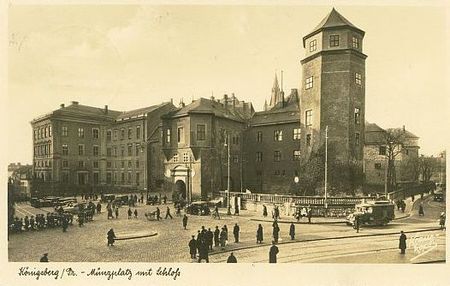Place of coronation of two Prussian Kings (Frederick I as King in Prussia and Wilhelm I, future German Emperor), by 1861 the Königsberg Castle was more than the walls and towers of the once Teutonic fortress. When Wilhelm I was coronated, the castle had incorporated the old defensive walls dating back from the Teutonic period (15th century), the Brick Gothic church (Schlosskirche) from 1594, the "Blood Court" (Blutgericht), a wine cellar built in the late 14th century, and some recent structures from the 18th and 19th centuries.

Konigsberg Castle: Brick gothic church and tower (middle), Blutgericht (right)
The Haberturm was the oldest tower (built ca. 1255) of the castle. It was the northeastern tower of the Schloss and a distinctive part of it, being visible from the other bank of the Schlossteich (Castle pond).

The castle contained also the Prussian Collection, with exhibits from the Prussian State Library and many art works.
All of this burnt down after the savage attack carried out by RAF in August 1944 - more than 800 airplanes bombed the city centre. Minor bombings by the Soviet air force, and later the Battle of Königsberg further damaged the castle. After the war, the Altstadt was no more than some destroyed buildings, the Königsberger Schloss and the shell of the Cathedral.

Königsberger Dom (Cathedral) as seen from the ruined Castle, 1949.
Despite all, the Castle walls remained standing. The end definetely came in 1968, when USSR leader Leonid Brezhnev decided to delete any sign of German past. The Schloss survived the first blast, - as a last showing of defiance to the Reds - that only torn down the brick gothic tower. A second explosion erased from Earth the remaining parts of this jewel (called "a symbol of Prussian fascism" by the Soviets, as other palaces like the Stadtschlösser in Berlin and Potsdam. The same they said, the same they did).
I have tried to make it the most accurate as possible, using a ground plan of the castle. The geometry work was the easy part - texturizing it was the difficult one. Although I could find many photos of the east, south and western parts, and three photocromes (Südseite, Ostseite and courtyard), I did not found pre-war photos of the northern side, for them I reviewed pictures displaying the ruined building.
Hope you like it.

 Picture from schneidemuehl.net.Note that the house next to it is still standing.
Picture from schneidemuehl.net.Note that the house next to it is still standing.





